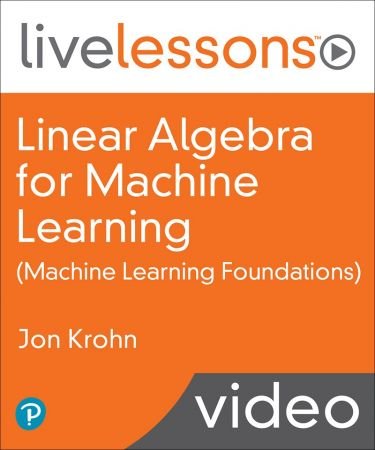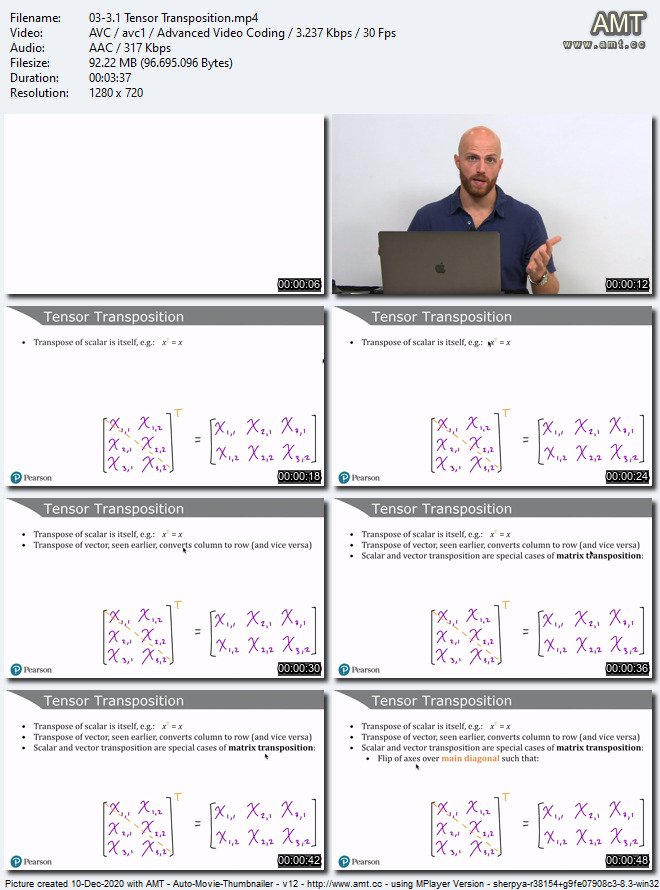 MP4 | Video: h264, 1280×720 | Audio: AAC, 44.1 KHz, 2 Ch
MP4 | Video: h264, 1280×720 | Audio: AAC, 44.1 KHz, 2 Ch
Genre: eLearning | Language: English | Duration: 58 Lessons (6h 32m) | Size: 11.3 GB
Overview
Linear Algebra for Machine Learning LiveLessons provides you with an understanding of the theory and practice of linear algebra, with a focus on machine learning applications.
About the Instructor
Jon Krohn is Chief Data Scientist at the machine learning company untapt. He authored the book Deep Learning Illustrated (Addison-Wesley, 2020), an instant #1 bestseller that has been translated into six languages. Jon is renowned for his compelling lectures, which he offers in-person at Columbia University and New York University, as well as online via O’Reilly, YouTube, and the Super Data Science Podcast. Jon holds a PhD from Oxford and has been publishing on machine learning in leading academic journals since 2010; his papers have been cited over a thousand times.
Skill Level
Intermediate
Learn How To
Appreciate the role of algebra in machine and deep learning
Understand the fundamentals of linear algebra, a ubiquitous approach for solving for unknowns within high-dimensional spaces
Develop a geometric intuition of what’s going on beneath the hood of machine learning algorithms, including those used for deep learning
Be able to more intimately grasp the details of machine learning papers as well as all of the other subjects that underlie ML, including calculus, statistics, and optimization algorithms
Manipulate tensors of all dimensionalities including scalars, vectors, and matrices, in all of the leading Python tensor libraries: NumPy, TensorFlow, and PyTorch
Reduce the dimensionality of complex spaces down to their most informative elements with techniques such as eigendecomposition (eigenvectors and eigenvalues), singular value decomposition, and principal components analysis
Who Should Take This Course
Users of high-level software libraries (e.g., scikit-learn, Keras, TensorFlow) to train or deploy machine learning algorithms who would now like to understand the fundamentals underlying the abstractions, enabling them to expand their capabilities
Software developers who would like to develop a firm foundation for the deployment of machine learning algorithms into production systems
Data scientists who would like to reinforce their understanding of the subjects at the core of their professional discipline
Data analysts or AI enthusiasts who would like to become a data scientist or data/ML engineer and are keen to deeply understand from the ground up the field they’re entering (very wise!)
Course Requirements
Mathematics: Familiarity with secondary school-level mathematics will make the course easier to follow. If you are comfortable dealing with quantitative information—such as understanding charts and rearranging simple equations—then you should be well-prepared to follow along with all of the mathematics.
Programming: All code demos are in Python so experience with it or another object-oriented programming language would be helpful for following along with the hands-on examples.
Lesson Descriptions
Lesson 1: Orientation to Linear Algebra
In Lesson 1, Jon starts with a definition of linear algebra. He then shows you how to use it to solve for unknowns in a system of linear equations. Next, he discusses why linear algebra is so crucial in modern machine learning, including deep learning. Finally, he finishes up with a brief history of algebra and some comprehension exercises.
Lesson 2: Data Structures for Algebra
Lesson 2 focuses on tensors, the fundamental data structure of linear algebra. Jon starts off with zero-dimensional scalar tensors. Then, he covers one-dimensional vector tensors, including the topics of transposition, norms, and unit vectors, as well as the bases for orthogonal and orthonormal vectors. The lesson wraps up with two-dimensional matrix tensors and higher-dimensional n tensors and a few exercises.
Lesson 3: Common Tensor Operations
Lesson 3 is about common tensor operations, including transposition, basic tensor arithmetic, reduction, and the dot product. It finishes up with exercises.
Lesson 4: Solving Linear Systems
In Lesson 4 you take a brief break from hands-on code demos to learn how to solve systems of linear systems by hand. The focus is on substitution and elimination strategies. The lesson finishes with exercises to reinforce those concepts.
Lesson 5: Matrix Multiplication
Lesson 5 is about matrix multiplication. Matrix-by-vector multiplication is covered first, followed by matrix-by-matrix multiplication. Next, the concepts of symmetric and identity matrices are discussed, followed by exercises that show their relevance to matrix multiplication. Finally, Jon wraps up with an explanation of the critical role of matrix multiplication in machine learning and deep learning applications.
Lesson 6: Special Matrices and Matrix Operations
Lesson 6 covers a number of special matrices and special matrix operations that are essential to machine learning. These include the Frobenius norm, matrix inversion, diagonal matrices, orthogonal matrices, and the trace operator.
Lesson 7: Eigenvectors and Eigenvalues
Lesson 7 begins with Jon discussing what the eigenconcept is all about. He follows this with some exercises to warm you up for playing around with eigenvectors in Python, including high-dimensional eigenvectors.
Lesson 8: Matrix Determinants and Decomposition
Jon begins Lesson 8 by illustrating how to calculate the determinant of a 2 x 2 matrix as well as the determinant for larger matrices. This prepares you for being able to work on some exercises on determinants on your own. The second half of the lesson discusses the relationship between determinants and eigenvalues and provides an overview of the broad range of eigendecomposition applications in the real world.
Lesson 9: Machine Learning with Linear Algebra
In Lesson 9 Jon helps you tie together many of the concepts you have been introduced to previously to power many useful machine learning applications. You learn singular value decomposition to compress a media file, the Moore-Penrose pseudoinverse to form a regression, and principal component analysis to break down a dataset into its most influential components. Finally, Jon provides you with resources for your further study of linear algebra.

Password/解压密码0daydown
Download rapidgator
https://rg.to/file/0318f5717f2b62641aa20fa4b76987e7/Linear_Algebra_for_Machine_Learning.part01.rar.html
https://rg.to/file/c252a4339f826d3ea3d642b4805ecf32/Linear_Algebra_for_Machine_Learning.part02.rar.html
https://rg.to/file/b5b1e905eacc57218ea7d420a39b49ac/Linear_Algebra_for_Machine_Learning.part03.rar.html
https://rg.to/file/f794cafc3e08cb8ea13f53aee845e0ca/Linear_Algebra_for_Machine_Learning.part04.rar.html
https://rg.to/file/d3a051a0134aac546f12f3918240f35a/Linear_Algebra_for_Machine_Learning.part05.rar.html
https://rg.to/file/213d48055444a5952013ecdebd494c92/Linear_Algebra_for_Machine_Learning.part06.rar.html
https://rg.to/file/7f905d2826ef4975676cc3ed2f401d84/Linear_Algebra_for_Machine_Learning.part07.rar.html
https://rg.to/file/3be0dc72210767a4bd2c9f9302a1cdcf/Linear_Algebra_for_Machine_Learning.part08.rar.html
https://rg.to/file/3550b28442952ea1006f9e64edf85dd8/Linear_Algebra_for_Machine_Learning.part09.rar.html
https://rg.to/file/a198861d5c13a45800c50edb9535a258/Linear_Algebra_for_Machine_Learning.part10.rar.html
https://rg.to/file/bee8feeee5335f0a25c4c9aa0e51e949/Linear_Algebra_for_Machine_Learning.part11.rar.html
https://rg.to/file/22c69f8f72838e31655addd8356f00e4/Linear_Algebra_for_Machine_Learning.part12.rar.html
Download nitroflare
https://nitroflare.com/view/8C8122EBB56985F/Linear_Algebra_for_Machine_Learning.part01.rar
https://nitroflare.com/view/184000AC5FFF3FE/Linear_Algebra_for_Machine_Learning.part02.rar
https://nitroflare.com/view/E06877D13D81228/Linear_Algebra_for_Machine_Learning.part03.rar
https://nitroflare.com/view/8371D1970CAD5FD/Linear_Algebra_for_Machine_Learning.part04.rar
https://nitroflare.com/view/9F19DD00B30E69D/Linear_Algebra_for_Machine_Learning.part05.rar
https://nitroflare.com/view/B25181C9579C216/Linear_Algebra_for_Machine_Learning.part06.rar
https://nitroflare.com/view/7B6B2BE62F4EE53/Linear_Algebra_for_Machine_Learning.part07.rar
https://nitroflare.com/view/F95C3050ECCBFEE/Linear_Algebra_for_Machine_Learning.part08.rar
https://nitroflare.com/view/3DA1133929A9617/Linear_Algebra_for_Machine_Learning.part09.rar
https://nitroflare.com/view/1B4C3714A4AF82D/Linear_Algebra_for_Machine_Learning.part10.rar
https://nitroflare.com/view/668DADD25BE56DC/Linear_Algebra_for_Machine_Learning.part11.rar
https://nitroflare.com/view/3F4CE1DC38C1C3E/Linear_Algebra_for_Machine_Learning.part12.rar